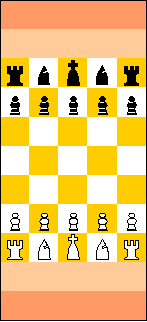Power Chess 1998
Power Chess is a chess variant invented by Ronald Hoekstra in 1998, as submission for the contest to design a chess variant on a board with 39 squares.Necessary materials
A chessboard (see image below), and for each player 5 pawns, two bishops, one king, and 4 dice. The board consists of 5 x 7 = 35 squares with at both small sizes two big fields. In total there are 39 fields.Starting setup
The starting setup is as follows:
 From top to bottom:
From top to bottom:
field
consisting of entire row;
another field consisting of entire
row;
row with rook, bishop, king, bishop, rook of black;
row with
five black pawns;
empty row with 5 squares;
empty row with 5
squares;
empty row with 5 squares;
row with 5 white pawns;
row
with rook, bishop, king, bishop, rook of white;
field consisting of
entire row;
field consisting of entire row.
Taken pieces
When a piece is taken, it goes to the backmost big field at the side of the player owning the piece. These fields may contain more than one piece. The player may, instead of making a normal move, move a piece from a big field to the next row. In one turn, one piece can be moved from the last big field to the first big field. In another later turn, the piece can then be moved to one of the five squares in the first row of the 5 by 7 part of the board.Hence, it takes two turns to bring a taken piece back on the playing area.
The big fields may not be entered in another way.
The pieces
Rooks and Bishops
All rooks and bishops have in addition a (6-sided) die. This die starts at the value 6. This is the maximum number of squares these pieces may go in one turn. When such a piece takes another piece, then its value is decreased by one. The minimal value is 1: a rook or bishop that has value 1 and takes another piece keeps the value 1.Rooks go horizontally or vertically, but may move around corners. See the following example:
----------------- | | | | | 4 ----------------- | | p | | | 3 ----------------- | p | | | x | 2 ----------------- | R | | K | | 1 ----------------- A B C DThe rook on A1 can go via b1, b2, c2, to take the piece
xon d2, supposing that the value on the die of the rook was at least 4.
Bishops go diagonally but may likewise may make turns. Here is another example:
----------------- | | | | | 4 ----------------- | | p | | | 3 ----------------- | p | | | k | 2 ----------------- | B | | | | 1 ----------------- A B C DThe bishop on a1 checks the king on d2 via b2 and c3, when the value on its die is at least three.
No piece may jump over another piece.
When they are taken, the value on the dice of bishops and rooks is unchanged. Bishops can reenter the game at squares of a different color than they first were on; in this way, a player can have both bishops on squares of the same color.
The king
The king moves as in orthodox chess. Castling is impossible.The pawns
A pawn moves as in chess. However, it may not move two squares on its first turn. En passant capture does not exist in this game. A pawn that reaches the other side of the board (disregarding the `large fields') promotes to bishop or rook, provided such a piece is available, i.e., a rook or bishop of the player is in one of the two big fields. In such a case, the rook or bishop is transferred to the position of the pawn, with its die set back to six, and the pawn is considered to be taken, i.e., goes back to the first big field.Object of the game
A player that mates or stalemates his opponent wins the game. Note that stalemate is also a win in this game. Note also that a player is not stalemated when he has a piece in a big field that can be moved to the other big field or to an empty square in the first row of the 5 by 7 area.Written and game design by Ronald Hoekstra in Dutch. Translation, diagram, and editing by Hans Bodlaender.
This is a submission for the contest to design a chess variant on a board with 39 squares.
WWW page created: June 29, 1998.